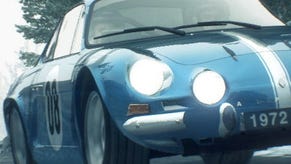Face-Off: DiRT 3
Photo finish.
Indeed, when cruising through the Swiss mountains, the sand-swept plains of Africa, or the cold industrial complexes of North America, you can easily see that DiRT 3 is a visually stunning release, with environments that are filled with distant valleys, long expanses of terrain, densely packed forests and more. In particular, the high point is clearly the lighting model; the way in which track-side scenery is beautifully reflected on the cars shiny exteriors, also accompanied by the spectacle of lens flare effects and sunshafts in the environments, both of which create a good degree of atmosphere throughout the game's many meticulously crafted courses. The lack of pop-in is also impressive, adding to the feeling that Codemasters has created a really solid, immersive game world.
Moving onto performance, and past DiRT titles have been known for their generally steady 30FPS update, but with the tendency to introduce torn frames when the engine is put under stress - usually smoothness is only lost in scenes which tax the engine. This is a key trade-off in maintaining a higher refresh rate, although in most cases tearing issn't particularly apparent outside of specific circumstances, with torn frames mainly being restricted to the upper part of the screen, or in the overscan area of the screen cut off on most HDTVs.
While DiRT 3 is very similar in this regard, performance appears to have been improved in some respects. A capped 30FPS update has been targeted once again, but there does appear to have been some optimisation to the point where the Xbox 360 version looks to all intents and purposes as though it is v-synced, with tearing only ever surfacing in only the rarest of situations. PS3 also appears to have improved in this regard over its predecessor, but it is still noticeable when things get really busy.
Analysis of both gameplay and external replays often yield very different results, with the wider field of view present in the replays (along with higher LOD cars) having a noticeable impact on performance. As such we decided to put together two separate videos: one showing performance during gameplay, and the other displaying the accompanying replays in similar scenarios.
First up, here's an extended look at the gameplay. Over the course of the video you can see the performance advantage that the Xbox 360 has, with the PlayStation 3 version introducing significantly more torn frames when there several cars on screen. Dust particles (and snow in particular) also seem to take their toll on performance on the Sony platform. The game also tears on the 360, but it happens far less often, with v-sync only being lost on a few rare occasions.
The question is whether the lost performance on the PlayStation 3 version translates into any tangible impact on the gameplay experience. In truth, much depends on the viewpoint you've chosen. In the traditional chase cam view, torn frames are mostly at the top of the screen and thus occupy an area of "dead space" taken up only by the skybox. When the tears do encroach lower, the fact that the difference between the two frames being rendered isn't that large also helps to make torn images slip by unnoticed.
However, switching to a bumper view camera does make the tears that much more apparent - the action looks faster from the lower viewpoint, more of the screen is taken up with rapidly changing detail, and so the tears are that much more obvious.
Fluctuating frame-rates are more of an issue - the reduction in controller feedback can be felt and as such precision can occasionally be lost in the heat of play. The game runs at a constant 30FPS for most of the time on both formats, with most dips in frame-rate being almost negligible on the 360 - commonly, we're talking about a two frame drop at the very worst in most cases, whereas on the PS3 there can be a few noticeable dips. A sustained performance level is important in giving you the sensation of a consistent, reliable relationship with the controls, and in those taxing areas, it is the 360 version that has a small edge. However, it is just a slight advantage, with any performance deficit on PS3 literally lasting just for a split-second.
Moving onto the replays, and in most cases you would expect performance in a similar set of scenes to be tangibly worse. The increased field of view would almost certainly put a greater strain on the engine, with the game rendering out larger areas of visible terrain at various points, while displaying several high LOD vehicles on screen along with a range of environmental effects.
However, the end results tally closely with our gameplay video - lots of frames are torn, while dips in smoothness are also present, with the PS3 coming off worse in this regard. But this isn't consistent across the board; generally speaking there's very little tearing outside of specific circumstances - in non-taxing situations it is often completely absent.






